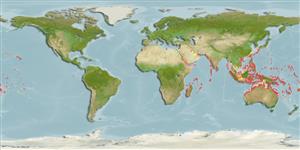Common names from other countries
Environment: milieu / climate zone / depth range / distribution range
Ecología
marino asociado a arrecife; rango de profundidad 0 - 30 m (Ref. 1602), usually ? - 10 m (Ref. 90102). Tropical; 36°N - 30°S, 30°E - 150°W
Indo-Pacific: Red Sea and East Africa to the Hawaiian and Society islands.
Tamaño / Peso / Age
Maturity: Lm ? range ? - ? cm
Max length : 18.0 cm TL macho / no sexado; (Ref. 4859)
Espinas dorsales (total): 13 - 15; Radios blandos dorsales (total): 14-16; Espinas anales 3-5; Radios blandos anales: 13 - 15.
Territorial species which occur in shallow lagoon and semi-protected seaward reefs (Ref. 48636). Benthopelagic (Ref. 58302). Closely associated with tabular and staghorn Acropora corals upon which they feed on their polyps and mucus. Solitary or in pairs. Juveniles secretive among coral branches (Ref. 48636). Oviparous (Ref. 205). Form pairs during breeding (Ref. 205). Minimum depth reported taken from Ref. 128797.
Life cycle and mating behavior
Madurez | Reproducción | Puesta | Huevos | Fecundidad | Larva
Distinct pairing (Ref. 205).
Myers, R.F., 1991. Micronesian reef fishes. Second Ed. Coral Graphics, Barrigada, Guam. 298 p. (Ref. 1602)
IUCN Red List Status (Ref. 130435)
CITES (Ref. 128078)
Not Evaluated
Threat to humans
Harmless
Human uses
Acuario: Comercial
Más información
ReferenciasAcuiculturaPerfil de acuiculturaRazasGenéticaElectrophoresesheritabilidadEnfermedadesProcesamientoMass conversion
Herramientas
Special reports
Download XML
Fuentes de Internet
Estimates based on models
Preferred temperature (Ref.
115969): 24.9 - 29.3, mean 28.3 (based on 2980 cells).
Phylogenetic diversity index (Ref.
82804): PD
50 = 0.5000 [Uniqueness, from 0.5 = low to 2.0 = high].
Bayesian length-weight: a=0.02138 (0.01361 - 0.03357), b=2.95 (2.82 - 3.08), in cm Total Length, based on LWR estimates for this species & Genus-body shape (Ref.
93245).
Nivel trófico (Ref.
69278): 3.3 ±0.6 se; based on diet studies.
Resiliencia (Ref.
120179): Alto, población duplicada en un tiempo mínimo inferior a 15 meses (K=0.5).
Fishing Vulnerability (Ref.
59153): Low vulnerability (11 of 100).
